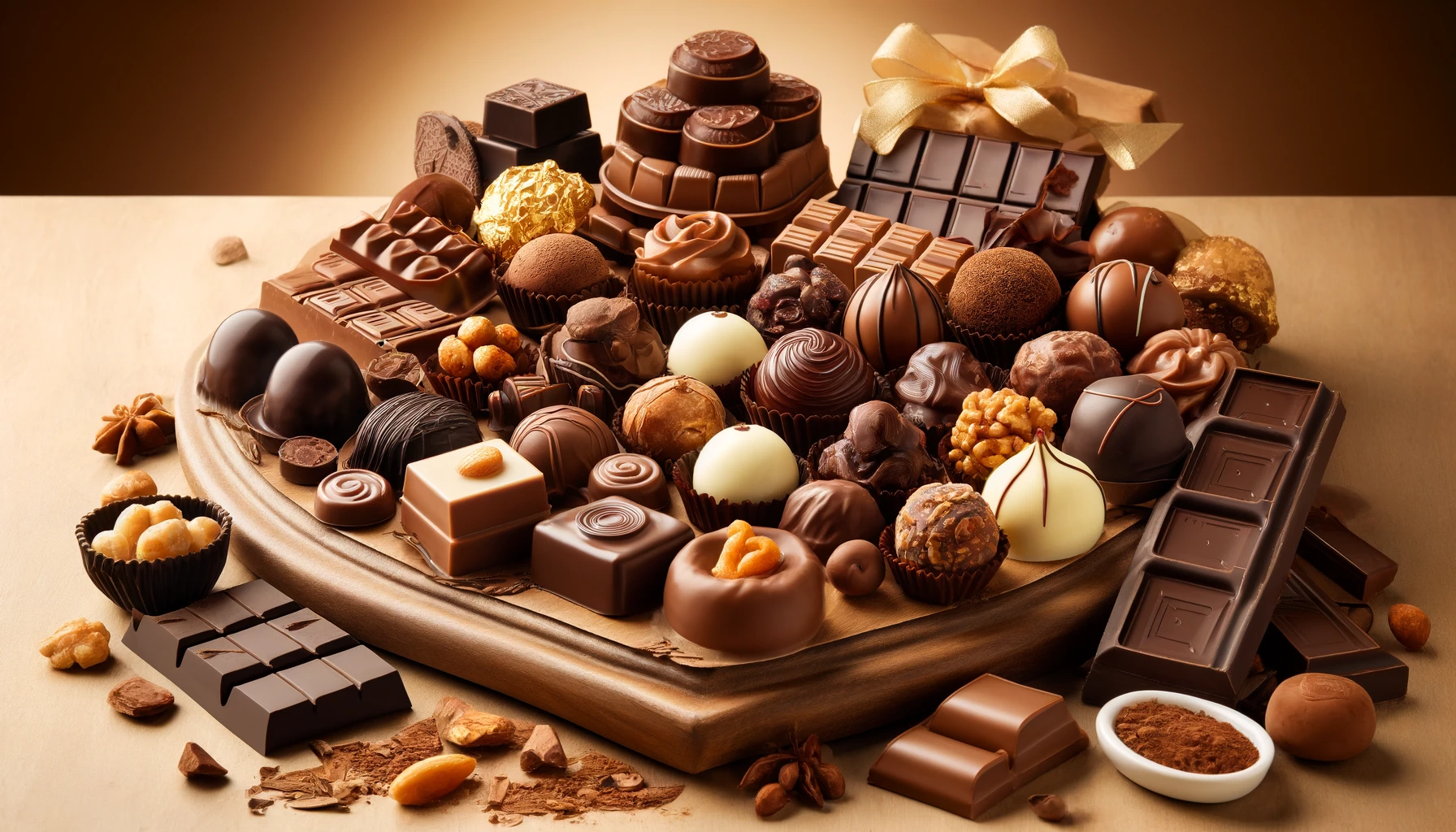
All About Chocolate
Kay
- 0
Chocolate, everyone loves chocolate! But, let’s be honest, who doesn’t? The sweet, rich, slightly bitter blend of flavours has been gracing our lips for over 3,000 years now, and it shows no sign of going away. Chocolate can be many things. It’s a tale of history, culture and even healthy food. So today let’s journey from the days of the Mayan rulers to the present and discover more about one of the world’s favorite foods.
The History of Chocolate
Ancient Origins
But just where did it all begin? Chocolate has origins more than 3,000 years ago in the ancient civilizations of Mesoamerica. The Olmec, Maya and Aztec would venerate the cocoa bean, ground into a ‘xocolatl’, or ‘bitter water’, the drink rarely sweetened and often spiced with chili and vanilla.
Chocolate’s Journey to Europe
They credit Christopher Columbus with bringing chocolate to Europe in 1502 on his fourth voyage to the Americas, though Hernán Cortés is the one who brought it back to Spain in the early 16th century. Europeans did not care for the drink, which was described as bitter, but they became keen chocolate consumers once sugar and cinnamon were added to the beverage (and it was also expensive).
Modern-Day Chocolate
Beginning in the 19th century chocolate production became refined. The development of the coaching process (which leads to the creation of its signature silky texture), and the invention of milk chocolate (developed by Daniel Peter and Henri Nestlé) set the stage for our present-day chocolate world. Chocolate is a global phenomenon. We eat it trillions of ways in our trillion-flavored lives.
Different Types of Chocolate
Dark Chocolate
Dark chocolate, or ‘plain chocolate’ as it’s sometimes called, contains 60 per cent or more of cocoa solids and cocoa butter. Due to its intense, slightly bitter taste, it’s the varietal preferred by so-called ‘chocolate aficionados’ and which is most often used to trumpet the health benefits of the treat.
Milk Chocolate
Milk chocolate, which is the most widely eaten chocolate in the world, contains milk solids. This makes it smoother and sweeter than dark chocolate. Milk chocolate is the key ingredient in candies and popular chocolate bars.
White Chocolate
White chocolate is fluffy, vanilla-flavored, and lacks cocoa solids. This sweet yet savory indulgence – softer and creamier than milk or dark chocolate – is often excluded from ‘real’ chocolate by connoisseurs, but still boasts its own loyal following.
Ruby Chocolate
Ruby chocolate is the latest member of the family as of 2017. Ruby chocolate gets its title from its signature pink color, which comes from a process that alters the natural properties of the ruby cocoa beans it contains. It’s fruity and slightly acidic in taste. Ruby chocolate is a pleasure to eat!
How Chocolate is Made
Harvesting Cocoa Beans
In effect, the road to chocolate starts by gathering its primary material: cocoa pods, which grow on cacao trees. When the pods are ready to be picked, cocoa beans inside are taken out and processed into all chocolate products.
Fermentation and Drying
After harvest, fermentation begins when the beans are placed in piles. From there, the moisture needs to be drawn out, resulting in a drier product that will be ready to move on towards the next steps of manufacturing.
Roasting and Grinding
Roasting the beans results in a delicious chocolate flavor. The beans are then cracked open and the shell taken away, leaving behind the cocoa nib. The nibs are then ground to a thick paste called cocoa liquor.
Conching and Tempering
In conching, the liquor is blended and aerated for hours, refining its texture and flavor. Tempering, the final step, entails cooling to precisely controlled temperatures, so that as much of the cocoa butter as possible solidifies in smooth, stable, glossy, swishy sheets, with a snap like a beaten duffel bag.
Molding and Packaging
Lastly, the tempered chocolate is poured into molds to form a chocolate bar or a chocolate piece of any shape. After it sets, the finished product can be packed for consumption by chocolate lovers around the world.
Health Benefits of Chocolate
Rich in Antioxidants
Containing antioxidant effects from large amounts of flavonoids, dark chocolate can help to keep free radicals under control and ease oxidative stress associated with chronic disease.
Improves Heart Health
It’s well documented, if you drink dark chocolate in moderation, it can help improve heart health by lowering blood pressure, improving blood flow and reducing your likelihood of heart disease because of the flavonoids inside.
Boosts Brain Function
Eating chocolate can also help your brain: flavonoids in cocoa improve brain blood flow, which in turn improves cognitive function and reduces the risk of neurodegenerative diseases.
Enhances Mood
Dark chocolate is well-known to make you feel good: it stimulates the brain to release endorphins and serotonin, the body’s happy chemicals, and makes you happier and better relaxed.
Supports Weight Management
It is a nice shock to learn that dark chocolate helps weight management in clinical doses. Dark chocolate reduces cravings, prevents hunger and develops fullness – all of which positively prevent overeating.
Benefits for Skin Health
The antioxidants found in chocolate can also help your skin, boosting hydration and density, and protecting against ultraviolet damage and acne, as well as boosting blood flow so you’ll radiate with good health.
Potential Anti-Cancer Properties
Here is a case when the components of a food product might be able to provide some kind of stronger protection. Some studies have shown that chocolate has anti-cancer effects because of the antioxidants that can protect cells from damage and lower the risk of some cancers.
How Chocolate Turns White
Ever see a white coating on your chocolate? It’s called ‘bloom’. There are two types of bloom: fat bloom and sugar bloom. Fat bloom appears when chocolate is exposed to fluctuating temperatures. When it happens, cocoa butter rises to the surface. Sugar bloom occurs when chocolate is exposed to moisture. The sugar in the chocolate dissolves on the surface and then recrystallizes. When either of these reactions occur, chocolate can develop a whitish coating and affect the texture of the frosting. In both cases, the chocolate is completely safe to eat. To avoid blooming, it’s best to keep chocolate in a cooler location and without fluctuations in temperature.
Popular Uses of Chocolate
In Baking and Desserts
Chocolate is one of the basic ingredients needed in bakery products and sweet pastries. This includes chocolate cakes, brownies, truffles, ganache and numerous other simple and complicated recipes.
In Beverages
Chocolate in drinkable form has been around almost as long as the candy itself: chocolate beverages such as the xocolatl of the ancient Aztecs (as well as the modern hot chocolate or chocolate milk) remain one of the most comforting and decadent ways to enjoy chocolate.
As Gifts
Chocolate is the gift of choice for nearly everything from Valentine’s Day to birthdays. It comes in assorted truffles, a printed chocolate bar, or a homemade chocolate creation. It’s an all-time favorite gift of love.
In Cooking
But sweetness aside, chocolate is actually a vital ingredient in savory cooking. Mole, the traditional sauce of Mexico, pairs chocolate with the earthier flavors of spices and chilies to create a deep, powerful amalgamation. Mole is often used to enhance the taste of meats and vegetables.
The Chocolate Industry Today
Major Players
Mega companies such as Mars, Nestlé and Hershey dominate in the chocolate industry and most of the market mostly comes from them. Their products include a wide range of tastes and prepears.
Economic Impact
Chocolate is big business: world production is in the billions of dollars, paying for millions of producers, factory workers, traders and other people who earn a living in the chocolate economy.
Sustainability Issues
The chocolate industry is the world’s second largest industry after oil, yet it is a severe cause for sustainability and not likely to meet the needs of future generations at that scale. The widespread use of child labor, unjust fair trade practices and the disastrous impact of chocolate production on the environment are huge problems that need to be tackled in order to be able to sustainably produce chocolate for future generations.
Conclusion
Chocolate matters – to science, human history, and the senses. It is not an everyday indulgence, but rather an everyday expertise, one that is now shared across the entire world. As long as there are chocolates, they will be eagerly sought after by more chocolatiers, pastry chefs, chocolate shops and specialized companies. Such is the magic of chocolate. Thus, the next time you bite into a square of your favorite chocolate, it’s time to savor a few small moments of its rich past and to take pride in all that humanity has created. Azizan and Tobarra’s article ‘Was Chocolate Really a Drink? The Archaeology of Cacao-Bean Tortillas in the Maya-Spanish Postconquest Documentary Record’ was published in Documenta Praehistorica 48 (2021), online at university museum.org. Photographs courtesy of the author – asteroid.
Frequently Asked Questions (FAQs)
What is the healthiest type of chocolate?
Dark chocolate has the greatest proportion of cocoa and is therefore the healthiest chocolate in terms of sugar content. It is high in antioxidants and has several health benefits.
How should chocolate be stored?
Chocolate should be stored away from heat, humidity and sunlight in a cool, dry place. To be perfect – kept in the range 60-70°F (15-21°C).
Can chocolate be part of a healthy diet?
Yes, in small quantities it can be included in a healthy diet – and dark chocolate is best as it has the highest percentage of cocoa.
Why does chocolate sometimes develop a white coating?
This white veneer is called bloom, when cocoa butter separates itself from the chocolate and migrates to the surface. It is innocuous but is adulterated by the touch, texture and taste of the chocolate below.
What is the difference between cocoa and cacao?
Cacao refers to the raw beans and tree from which they grow, while cocoa refers to the chocolate product made from the processing of the beans. They are often used interchangeably, though cacao often refers to less processed products compared with the term cocoa.
Samsung Galaxy S21 iPhone 11 Samsung Galaxy A51 LG G8 ThinQ Samsung Galaxy Z Fold2 LG G8 ThinQ Samsung Galaxy S21 LG K40 LG K40 LG G8 ThinQ

